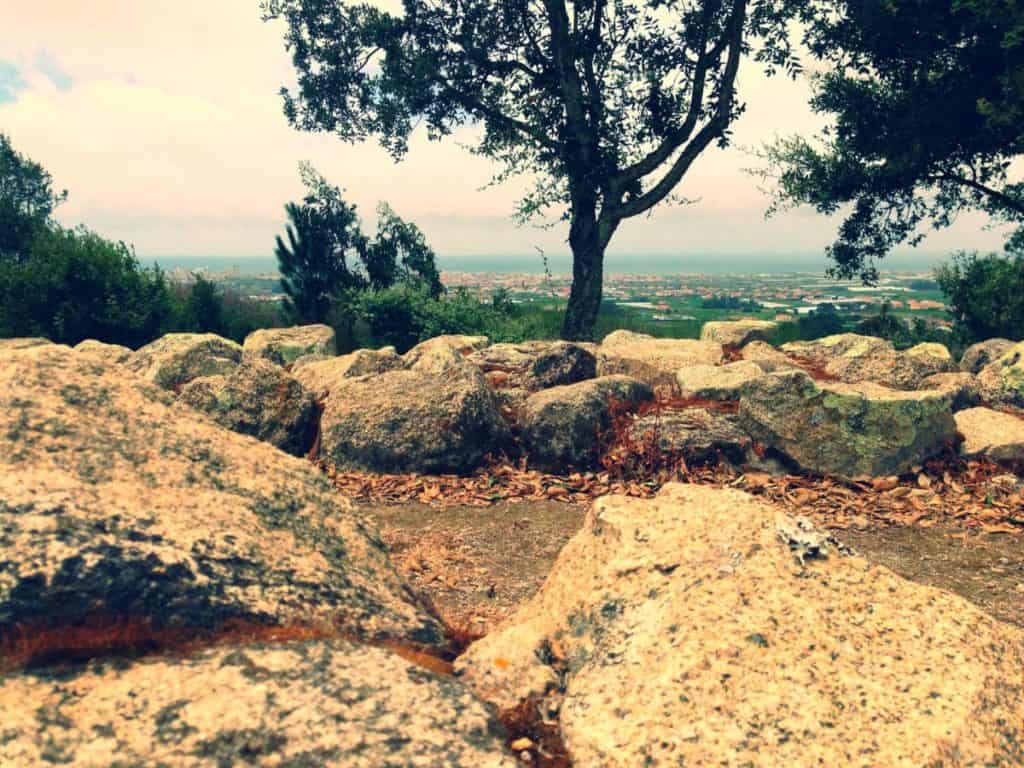Summary
- Igreja de São Pedro de Rates
- Cividade de Terroso
- Painel de Azulejos
- Museu Municipal de Etnografia e História
- Praia da Salgueira
- Praça do Almada
- Casino da Póvoa
- Fortaleza de Nossa Senhora da Conceição
- Avenida dos Banhos
- Farol da Lapa
- Golf
- Other Beaches
- Santa Clara Aqueduct
- Monte de São Félix
- Food and Drink
Half an hour north of Porto, Póvoa de Varzim is a coastal destination that first attracted visitors in the 1800s.
In the 19th century, it served as a meeting point for diverse cultures: Fishermen struggled to make a living using traditional Poveiro sailboats, while affluent individuals flocked to the town to enjoy its beaches, celebrated for their therapeutic seaweed.
Visitors can fully indulge in the local lifestyle, relishing seafood, relaxing on pristine sandy beaches, trying their fortune at the renowned casino, or engaging in a round of golf at the nearby course.
However, Póvoa’s rich heritage is also preserved, evident in a stunning tile panel adjacent to the fishing harbor and at the local museum, which showcases traditional Póvoa vessels.
Let us explore the best attractions in Póvoa de Varzim:
1. Igreja de São Pedro de Rates

A monastic church has existed on the site where São Pedro de Rates stands since the 800s, with its current Romanesque architecture dating back to the 1000s and 1100s.
This makes it one of the oldest intact Romanesque churches in Portugal.
All the hallmark features of the era are present: The archivolt and tympanum of the main portal exhibit faded yet recognizable carvings of Jesus and various saints.
The internal carvings are better preserved, visible in the column capitals of the nave, apse, and transept, as well as adorning numerous arches with images of people, animals, and geometric patterns.
2. Cividade de Terroso

Situated a short distance inland is one of the most well-preserved castros (Bronze Age settlements) in Northern Portugal.
It is remarkable how much of this 12-hectare site remains intact, despite being abandoned nearly two millennia ago.
The earliest artifacts date back almost 3,000 years, featuring an acropolis surrounded by three layers of defensive walls and numerous circular dwellings.
One intriguing aspect is that the streets between the houses still retain their original paving, a remnant from Roman times.
In some areas, narrow channels have been carved into the stone for sewage or to manage rainwater runoff.
3. Painel de Azulejos

On the breakwater that separates the sandy beach from the fishing port is a tile panel created by artist Fernando Gonçalves in 2004. This charming sight is well-regarded, featuring illumination from below at night.
The panels illustrate various scenes from the city’s history, showcasing Póvoa de Varzim’s historic trams, the 19th-century tourist waterfront, and several traditions (such as traditional attire, “Poveiro” boats, and the waterfront fish market) that have become a part of the past.
Additionally, there are panels featuring some of the city’s notable figures, ranging from military leaders and politicians to musicians.
4. Museu Municipal de Etnografia e História

For those captivated by the maritime heritage and fishing traditions of the past, this museum offers insights into the traditional life of Póvoa de Varzim.
Housed in the Solar dos Carneiros, an elegant mansion from the late 18th century, the museum also features a preserved chapel as part of the visit.
As it belonged to a noble family (the Count of Azevedo), visitors can gain perspective on the living conditions of the affluent in the 19th and early 20th centuries.
Moreover, the museum documents the daily hardships faced by Póvoa’s maritime community, such as a tragic storm in 1892 that claimed the lives of 105 fishermen, and allows visitors to view authentic Poveiro boats.
These exhibits are supplemented by intriguing artifacts dating back to the medieval period, Roman times, and the Castro culture that preceded them.
5. Praia da Salgueira

This beach was historically favored by the affluent for bathing in the 19th century.
With its expansive stretch of white sand, it attracts numerous visitors during the summer months.
Parallel to the beach is Avenida dos Banhos, ensuring that amenities are readily available.
Generally, the beach is free of rocks, except for the northern section where a bar complex is situated.
Bodyboarders favor Praia da Salgueira, and ideal conditions for surfing can also arise during high tides.
6. Praça do Almada

Many notable sites in Póvoa de Varzim are located in this central square, once home to the city’s bourgeoisie in the 19th century.
Begin at the arcaded town hall, built in 1791 and designed in the Neoclassical style by French military architect Reinaldo Oudinot.
The Pelourinho serves as Póvoa de Varzim’s town pillory, sculpted in the Manueline style during the 1500s.
The colorful houses on the eastern end of the square present an aesthetically pleasing backdrop for the statue of writer José Maria de Éça de Queirós, a prominent figure of 19th-century Portuguese literature.
He was born just a short distance from this monument.
7. Casino da Póvoa

No reputable spa resort would lack a classic casino.
Póvoa de Varzim’s casino dates back to the early 1930s and is designed in the Beaux-Arts style, inspired by the works of Charles Garnier in Paris.
Visitors can enjoy playing baccarat, roulette, and blackjack, along with a choice of hundreds of slot machines.
The gaming area is further complemented by an upscale restaurant, a theatre, and no less than five bars.
Be sure to reserve a table at the restaurant, adorned with contemporary Portuguese art by renowned artists such as Rogério Ribeiro and Graça Morais.
8. Fortaleza de Nossa Senhora da Conceição

A fortification has stood here since the 1400s; however, the current fortress was constructed in the early 18th century.
This occurred during the reign of Peter II and John V, establishing a pentagonal layout to safeguard the town’s fishing interests from pirate attacks.
The fortress has recently undergone restoration, now housing a café and restaurant.
Visitors can admire the 1743 chapel and enjoy panoramic views of the fishing port.
Additionally, take note of the bartizans at the corners of the walls and the coat of arms of Diogo de Sousa, the governor responsible for its construction, located above the main entrance.
9. Avenida dos Banhos

Stretching for almost a kilometer along Póvoa’s beaches, Avenida dos Banhos is an oceanfront roadway and promenade, laid out in the 19th century.
It was envisioned as Portugal’s answer to the luxurious beachfront walks seen in cities like Nice or Oostende.
For many years, the city’s trams passed along this road, and amid the apartment buildings from the 60s and 70s, hints of history linger in places like Café Guarda-Sol, Portugal’s oldest beach bar, and the Diana-Bar.
The latter, an Art Deco pavilion that once served as a café, has been transformed into a public library.
A dedicated bikeway runs parallel to the road, extending along the coast all the way to the Ave River at Vila do Conde, several kilometers southward.
10. Farol da Lapa

After experiencing the more glamorous attractions such as the casino, Avenida dos Banhos, and Praça do Almada, consider exploring the modest fishing quarter located behind the marina.
A peculiar monument features a lighthouse beacon above the rear façade of a church within this low-rise residential area.
A light has existed on this site since the 1500s, while the church originates from the 1770s.
The lighthouse was decommissioned in the 1960s but has since been restored and reopened as a tourist attraction in recent years.
Under the lantern, a tile panel commemorates the tragic fishing boat disaster of 1892.
11. Golf

A short distance up the coast lies an authentic links course: At Estela Golf Club, golfers can enjoy breathtaking ocean views, undulating fairways, and expansive greens reminiscent of fabled courses in Ireland and Scotland.
Nonetheless, Estela offers much more sunshine, minimizing the discomfort of ocean squalls.
The 18-hole par 72 course hugs the coastline, extending for three kilometers, ensuring continuous views of the Atlantic Ocean.
These ocean breezes introduce a challenge not present on the more sheltered courses found in the Algarve.
12. Other Beaches

Salgueira is merely one of several beaches either directly along Póvoa’s coastline or up the coast, where tranquility reigns.
The closest beaches to the city center are Redonda and Carvalhido.
The latter is easily recognized by its belvedere, a raised walkway overlooking a collection of bars and restaurants, providing sweeping views of the Atlantic.
Further along the coast, beaches extend for several kilometers, including Praia Verde, Praia da Lagoa-II, Praia da Fragosa, and Praia do Esteiro.
All boast an enticing mix of expansive soft sands and vibrant surf, while the urban landscape continues to diminish behind them.
13. Santa Clara Aqueduct

In the surrounding countryside of Póvoa de Varzim, this massive 17th and 18th-century aqueduct is hard to overlook.
It stands as the second-largest aqueduct in Portugal, constructed to transport spring water from Terroso to the Convent of Santa Clara in Vila do Conde, located four kilometers south, addressing a longstanding water supply issue.
When operational, it featured 999 granite arches, with the first waters flowing through in 1714. Nowadays, the aqueduct serves solely a monumental purpose, leading its framework into the historical shipbuilding city of Vila do Conde.
14. Monte de São Félix

The Serra de Rates is a range of hills that rise prominently from the coastal plain of Póvoa.
The tallest of these hills is Monte de São Félix, standing at just over 200 meters.
As is often the case in Portugal, a religious sanctuary crowns this hill, and a substantial staircase commences at the foot, making the ascent more accessible.
This pathway cuts through the hill’s pine forest and leads to a terrace in front of Capela de São Félix, offering invigorating views of the coast.
Take the time to explore the area, as remnants of old windmills and the pre-Roman ruins of the Castro de Laundos, an outlying community associated with Cividade de Terroso, await discovery.
15. Food and Drink

The signature local dish is named after the city itself: Pescada à Poveira, typically prepared with hake and accompanied by potatoes, eggs, onions, and seasoned with vinegar and sweet paprika.
It is unsurprising, given Póvoa de Varzim’s fishing heritage, that nearly all traditional dishes derive from marine sources.
Arroz de marisco features rice simmered with shellfish, while sardines are the primary ingredient in arroz de sardinhas.
Caldeirada de peixe is a stew composed of an assortment of oily fish, whitefish, and various seafood, while lulas recheadas consist of squid stuffed with potatoes and eggs.
A perfect accompaniment to this seafood fare is crisp and refreshing vinho verde from the Minho valley.





